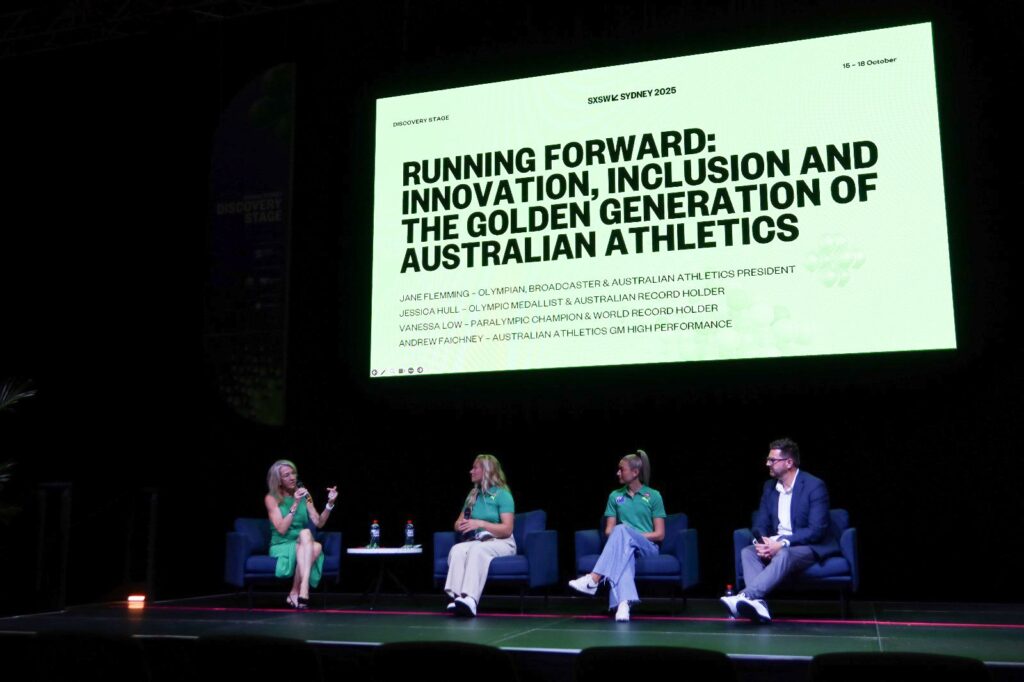
When Australian Athletics took to the stage at SXSW Sydney last week, it wasn’t to celebrate medals, it was to explore ideas.
In a forum dedicated to creativity, innovation and impact, our session Running Forward: Innovation, Inclusion and the Golden Generation of Australian Athletics saw President Jane Flemming join Olympic medallist Jessica Hull, Paralympic champion Vanessa Hull and General Manager – High Performance, Andrew Faichney unpack the forces propelling Australia’s new golden era of athletics.
From cutting-edge performance science to the integrated high-performance system uniting Para and able-bodied athletes to the cultural values driving success, the conversation revealed how athletics has become a model for transformation across Australian sport.
Innovation is not optional
In a sport where hundredths of a second and millimetres separate medals from near-misses, innovation isn’t a buzzword, it’s a necessity. Our high-performance program is built around that reality.
As Flemming opened: “We have no choice but to innovate.”
For Australia’s athletes and coaches, innovation now spans every layer of performance, from biomechanics and physiology to recovery, footwear and prosthetic design:
This is where Australian Athletics is leading – in using innovation not to replace the human element but to amplify it.
One sport, one system
One of the defining themes at SXSW Sydney was the way Australia has built a unified high-performance program that brings para and able-bodied athletes together under one system.
Faichney shared that across State Institutes and Academies, “we don’t have a para program and an able-bodied program. We have an athletics program.”
And the benefits have been profound:
The result is a structure that is not only more inclusive but more effective – a system where equality and excellence reinforce each other.
Equity is a competitive advantage
Low and Flemming both spoke about equity as a performance principle.
In Para-sport, technology and access remain central to fairness, yet regulation can’t exist in isolation.
“The IPC has been trying to balance innovation and accessibility for years but sport isn’t just about competition. It’s about enabling people around the world to participate,” Low said.
Through solidarity programs and shared innovation, the growth of Paralympic athletes has opened opportunities for athletes who once lacked access to technology or competition.
Low summed it up: “When people with different abilities compete side-by-side, that’s when true inclusion happens.”
As Flemming told the audience, fairness and innovation are not opposing forces. They’re parallel tracks leading to the same finish line.
Momentum you can measure, and feel
More than nine million Australians tuned into the World Athletics Championships in Tokyo, with athletics ranking among the year’s top TV moments.
The on-field story is equally compelling: medals across a broad span of events; high jump and discus, pole vault and race walks, middle-distance on the track and all mirrored by podium success in Para events. That diversity matters. It tells every junior at Little Athletics, every member of a run club, that there is a place for you in Australian athletics.
And there’s character behind the results. What defines this generation beyond talent, is courage and authenticity.
Athletes are saying out loud that they want to win. They risk silver to chase a world record. They front cameras as themselves. That honesty is why Australians are leaning in and it’s why the grandstand roar can carry someone the last five metres when nerves bite.
From community to continuum
The gift of the last few years has been the explosion of social running. Run clubs, Parkrun, grass ovals. Athletics meets where Olympians warm up alongside ten-year-olds and the barriers to getting involved in cost, kit, time are lower than almost any other sport.
And the benefits – fitness, social cohesion, confidence – are enormous.
For many of our athletes, the loop closes locally. Jessica Hull still trains on the track where she started. Vanessa Low speaks in schools so kids can “see it, to be it.” When a national team athlete turns up at a community event, the message is unmistakable: this stage is yours one day; start here.
Flemming closed the loop beautifully:
“Sport has become one of the few platforms that unites a nation. Athletics sits at the foundation of that connection. It’s something every Australian can relate to, because we’ve all tried to run as fast as we can or jump as far as we can.”
Athletics isn’t just a sport. It’s a reflection of human movement, human ambition and human possibility.
Partners who move the mission
Innovation and inclusion thrive when values align. At SXSW, Australian Athletics highlighted partnerships that turn shared purpose into real progress:
Each represents a different aspect of what’s possible when commercial investment meets genuine intent, partnerships that amplify both performance and impact.
From SXSW to 2032
The SXSW stage was a window into the future of the sport. One where technology, equity and community are no longer separate conversations, but one continuum.
Australian Athletics is embracing that future with purpose:
A home Olympics will compress generations: the stars of today sharing call rooms with kids who first noticed athletics watching the likes of Jessica Hull and Vanessa Low on TV. That’s an opportunity and responsibility.
As Faichney concluded: “We are in a golden age, and our ambition now matches our talent. Everyone’s watching. It’s an exciting time to be here.”
Our job is to ensure they don’t just watch, they join in.
By Sascha Ryner, Australian Athletics
Posted: 22/10/2026

